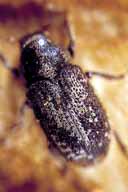Silver fir beetle
Pseudohylesinus sericeus (Mannerheim) (Coleoptera: Curculionidae, Scolytinae)
Orientation to pest
The silver fir beetle, Pseudohylesinus sericeus (Mannerheim), is a minor pest that attacks windthrown, felled, injured, and severely suppressed trees. The damage it causes is rarely important. However, in the 1940s and 1950s, large outbreaks occurred on Pacific silver fir (Abies amabilis Douglas ex J.Forbes) in the Pacific Northwest of the United States. In Oregon, there is one generation per year, but in Washington, a generation requires two years. The egg gallery is transverse. In large trees, attacks occur in the upper bole and limbs. The beetle often attacks trees that are infected with brown-stain or root-rotting fungi such as Armillaria sp., Heterobasidion annosum (Fr.) Bref., and Phellinus weirii (Murrill) Gilbert.
Hosts commonly attacked
The principal hosts of the silver fir beetle are various fir (Abies), western hemlock (Tsuga heterophylla [Raf.] Sarg.), and Douglas-fir (Pseudotsuga menziesii [Mirb.] Franco).
Distribution
The silver fir beetle ranges principally from British Columbia to California and eastward to northern Idaho. It also may occur in southeast Alaska and western Montana.
Images of silver fir beetle
| Figure 1. Adult of Pseudohylesinus sp. |
Important biological control agents related to this pest species
The natural enemies of silver fir beetle are unknown.
Web links for information on silver fir beetle
- Ministry of Forests and Range Fact Sheet | Province of British Columbia
- Forest Insect & Disease Leaflet 60 | USDA Forest Service
Articles
- Gara, R. I. 1982. Insect pests of true firs in the Pacific Northwest. In: Oliver, C.D. and R. M. Kenady (eds.). Proceedings of the biology and management of true fir in the Pacific Northwest. Seattle-Tacoma, Washington, February 24-26, 1981. Contribution, Institute of Forest Resources, University of Washington(45): 157-160.




